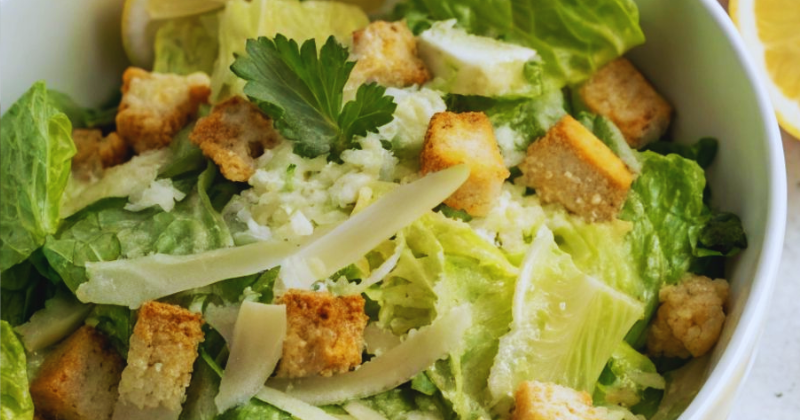Prep Time: 20 minutes/ Total Time: 20 minutes/ Serves: 4-6 people/ Difficulty: Easy to Moderate.
Table of Contents
I’ll never forget the first time I watched my grandmother make her famous Caesar salad from scratch. I was eight years old, perched on a kitchen stool, mesmerized as she whisked together what seemed like magic in a wooden bowl. The sharp aroma of fresh garlic mingling with anchovies, the satisfying crack of perfectly poached eggs, and that final flourish of freshly grated Parmesan – it was culinary theater at its finest. That homemade Caesar salad became the gold standard in our family, and today I’m sharing those time-tested secrets with you. This isn’t just another salad recipe; it’s a masterclass in creating restaurant-quality Caesar salad in your own kitchen, complete with a dressing so good you’ll never buy bottled again.
Why You’ll Love This Homemade Caesar Salad Recipe
This classic Caesar salad will revolutionize your approach to simple, elegant dining. First, you’ll save money – restaurant Caesar salads often cost $12-15, while this homemade version feeds a family for under $8. The flavor difference is remarkable; fresh ingredients and made-to-order dressing create layers of complexity that bottled versions simply can’t match. You control every ingredient, making it family-friendly and adaptable to dietary needs without mysterious preservatives or additives. The preparation is surprisingly easy once you understand the technique, taking just 20 minutes from start to finish. Most importantly, this recipe creates those special dinner moments – there’s something magical about tossing a fresh Caesar salad tableside that transforms an ordinary meal into an occasion. The combination of crispy romaine, creamy dressing, and crunchy croutons delivers perfect textural contrast in every bite.
Ingredient Insights & Selection Guide
The secret to an exceptional Caesar salad recipe lies in selecting premium ingredients and understanding their roles. Romaine lettuce forms the foundation – choose heads with crisp, dark outer leaves and pale, tender hearts. Avoid pre-washed bags; whole heads stay fresher longer and provide better texture. For the dressing, quality anchovies are non-negotiable – look for salt-packed varieties from Italy or Spain, which offer deeper flavor than oil-packed options. Fresh garlic should be firm with no green shoots, while lemons should feel heavy for their size, indicating maximum juice content. Parmesan cheese must be authentic Parmigiano-Reggiano, aged at least 12 months for optimal flavor and easy grating. Eggs should be the freshest possible – check the date and perform the water test if uncertain. For dietary adaptations, vegetarian Worcestershire sauce replaces traditional versions, while vegan options can substitute nutritional yeast for Parmesan and omit eggs entirely. Store ingredients properly: keep lettuce refrigerated in paper towels, anchovies sealed after opening, and Parmesan wrapped in parchment paper.
Key Techniques & Method Overview
Mastering Caesar salad requires understanding four essential techniques that separate good from extraordinary. Emulsification is crucial for the dressing – slowly adding oil while whisking creates a creamy, stable mixture that coats lettuce beautifully rather than pooling at the bottom. The traditional method involves mashing garlic and anchovies into a paste with the flat side of a knife, releasing maximum flavor compounds. Egg preparation varies by preference and safety concerns; codding (briefly boiling) eggs for exactly one minute creates food-safe results while maintaining the creamy texture that makes Caesar dressing legendary. Lettuce preparation involves more than washing – leaves should be completely dry (use a salad spinner), torn rather than cut to prevent browning, and chilled until serving for maximum crispness. The tossing technique is often overlooked but vital; gentle folding motions preserve delicate lettuce structure while ensuring even dressing distribution. Timing coordination ensures all components come together at peak quality – croutons should be warm, dressing at room temperature, and lettuce cold and crisp.

Step-by-Step Caesar Salad Instructions
1. Prepare the lettuce (5 minutes): Remove outer leaves from 2 large romaine hearts, reserving them for another use. Separate remaining leaves, wash thoroughly in cold water, and spin completely dry. Tear leaves into bite-sized pieces, aiming for 2-3 inch segments. Refrigerate in a clean kitchen towel while preparing other components.
2. Create the garlic-anchovy base (3 minutes): On a cutting board, sprinkle 2 garlic cloves with coarse salt. Using the flat side of your knife, mash into a smooth paste. Add 4-6 anchovy fillets and continue mashing until mixture forms a uniform paste. The salt acts as an abrasive, breaking down fibers more effectively than mincing alone.
3. Build the dressing (8 minutes): In a large mixing bowl, combine the garlic-anchovy paste with 2 tablespoons fresh lemon juice and 1 teaspoon Worcestershire sauce. Crack in 1 coddled egg (or 2 egg yolks if preferred) and whisk vigorously. Slowly drizzle ⅓ cup extra-virgin olive oil while whisking constantly – the mixture should thicken and turn creamy. Season with freshly cracked black pepper.
4. Combine and toss (2 minutes): Add chilled romaine to the bowl and toss gently but thoroughly, ensuring every leaf is coated. Add ½ cup freshly grated Parmesan and 1 cup homemade croutons. Toss once more gently.
5. Final presentation (2 minutes): Transfer to chilled serving plates or one large platter. Top with additional Parmesan shavings and a few grinds of black pepper. Serve immediately while lettuce remains crisp and croutons are still warm.
Pro Tips & Troubleshooting for Perfect Results
Temperature control makes the difference between good and great – serve Caesar salad on chilled plates with cold lettuce and room-temperature dressing for optimal contrast. If your dressing breaks (appears oily rather than creamy), start fresh with an egg yolk in a clean bowl and slowly whisk the broken dressing back in. Anchovy hesitation is common, but these little fish dissolve completely, adding depth without fishiness – start with fewer if concerned, but don’t omit entirely. Make-ahead strategy involves preparing components separately: dressing keeps refrigerated for up to 3 days, croutons stay crisp in airtight containers for a week, and lettuce can be washed and dried up to 2 days ahead. For crowd-pleasing portions, use approximately 2 cups lettuce per person and ¼ cup dressing. Leftover management requires immediate attention – dressed salad doesn’t keep, but components stored separately maintain quality for next-day assembly.
Creative Variations & Customizations
Transform your Caesar salad recipe with seasonal adaptations and dietary modifications. Protein additions like grilled chicken, shrimp, or salmon create satisfying main courses, while vegetarian options might include roasted chickpeas or marinated tofu. Keto-friendly versions double the Parmesan and add avocado while omitting croutons. Gluten-free adaptations substitute homemade gluten-free croutons or toasted nuts for traditional bread cubes. Seasonal variations incorporate grilled romaine in summer or add roasted vegetables in winter. International twists might include Asian Caesar with sesame oil and nori, or Mexican versions with lime and cotija cheese. For lighter versions, reduce oil by half and add Greek yogurt for creaminess.
Storage, Reheating & Make-Ahead Tips
Dressed Caesar salad doesn’t store well – lettuce wilts and loses crispness within hours. However, smart component storage extends your options significantly. Homemade dressing keeps refrigerated for up to one week in an airtight container; bring to room temperature and whisk before using. Lettuce preparation up to 48 hours ahead involves washing, drying thoroughly, and storing wrapped in paper towels inside plastic bags. Croutons remain crisp for up to one week at room temperature in airtight containers; refresh in a 350°F oven for 2-3 minutes if needed. Parmesan keeps fresh when properly wrapped in parchment paper rather than plastic, maintaining optimal texture for grating. Assembly timing should happen just before serving to preserve textural contrasts that make Caesar salad exceptional.
Serving Suggestions & Perfect Pairings
Classic Caesar salad shines as both appetizer and main course, depending on accompaniments and portion size. Wine pairings favor crisp whites like Sauvignon Blanc or unoaked Chardonnay, whose acidity complements the rich dressing without overwhelming delicate lettuce. Complete meal ideas include pairing with grilled steaks, roasted chicken, or seafood for elegant dinner parties. Casual dining options work beautifully alongside pizza, pasta, or hearty soups. Garnish creativity extends beyond traditional Parmesan – try toasted pine nuts, crispy pancetta, or even edible flowers for special occasions. Bread accompaniments like warm focaccia or crusty baguette slices help diners enjoy every drop of that magnificent dressing.
Ready to create restaurant-quality Caesar salad magic in your own kitchen? This recipe transforms simple ingredients into something truly special, just like my grandmother’s version that started my lifelong love affair with great food. Gather your ingredients, invite someone special to watch the show, and prepare to fall in love with homemade Caesar salad all over again.

